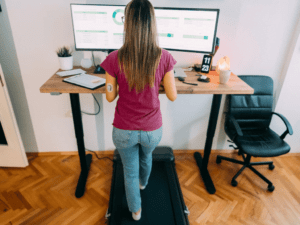Nowadays, many people work remotely, so they sit for long hours. This can lead to adverse health effects. A standing desk is a solution that can help ease these negative effects. It allows you to stand while working, which can help you focus better and maintain a healthier routine
However, choosing the perfect standing desk tailored to your needs is critical for maintaining well-being during work hours. This shift towards a more versatile workspace setup is more than just a convenience – it’s a fundamental step towards a healthier, more productive work lifestyle.
If you are interested in more detail, then read our detailed guide What is a standing desk given below.
What is a Standing Desk? (Detailed Overview)

Below is the detailed analysis of : what is a standing desk? A standing desk is a versatile alternative to a conventional seated office setup. It allows individuals to work while standing.
A standing desk can be defined as a desk used to work comfortably in a standing position. These desks are manufactured in a way that improves your overall productivity without facing any physical pressure or health issues.
Various styles and variations of standing desks are available, and some manufacturers can even design bespoke creations to suit specific needs. For instance, standing desks are designed for architectural drafting, web development, graphic design, digital content production, or making and receiving calls.
Standing desks are of various types. Some desks are used in one fixed standing position, while others can be adjusted to sit or stand. Adjustable desks contain electric motors, counterbalances, or hand crank systems; through this system, you can change your seat height from 70 cm to 128cm, making it easy to fit the desk that matches your preferred standing height.
Compared to traditional work desks, the flexibility to change things up as you please sounds like an ergonomic dream. Unlike the fixed position of seated desks, standing desks are custom-designed with adjustable parts to support correct posture and your physical well-being. In short, you are making working life all the easier by using a standing desk.
What are the Types of Standing Desks?
There are different types of standing desks. Each type has unique features that cater to other work preferences and environments. Knowing these differences will help you choose the most suitable standing desk.
Types of Standing Desks
There are different types of standing desks. Each type has unique features that cater to other work preferences and environments. Knowing these differences will help you choose the most suitable standing desk.
1. Height-Adjustable Standing Desks

Standing desks with adjustable heights are a common choice because they offer flexibility to users. The desks can be customized to fit different body sizes, preferences, and ergonomic needs.
2. Standing Desk Converters
Standing desk converters are ideal for individuals with existing seated desks who seek a flexible option. These converters can be placed atop traditional desks to create an instant secondary standing workspace.
However, their smaller size and weight limitations may restrict the setup of multiple monitors or heavier equipment.
3. L-Shaped Smart Desk

The L-shaped Smart Desk is designed to maximize space utilization, especially for those working in confined or cornered areas. Powered by a robust triple motor system, this desk provides ample support and lift capacity, accommodating up to 330 lbs. Its versatile tabletop, with two interchangeable pieces, allows customization to fit into various corner spaces effectively.
Read more:>>>> Discover Hidden Advantages of L-Shaped Desks! Updated 2025
4. Smart Desk – Double Desk
The Smart Desk: Double Desk offers both privacy and collaboration in shared workspaces. It features two adjustable standing desks that can be controlled independently.
The power beam outlet, equipped with USB, AC, Ethernet, and phone ports, enhances connectivity for two users. Additionally, wire management ensures a clutter-free workspace for improved productivity.
5. Fixed-Height Standing Desk
Fixed-height standing desks, often called Bar Tables, provide a raised flat surface but lack height adjustability. While more durable and cost-effective due to fewer moving parts, they do not offer flexibility in altering the desk height once installed.
Each type of standing desk caters to different needs, whether for adjustable height preferences, space considerations, or shared work environments. Choosing the right standing desk depends on individual requirements and intended usage, whether for personal or collaborative work setups.
What are the Benefits of Standing Desk?

1. Reduces the Risk of Obesity and Weight Gain
When you use a standing desk for work, you lose almost 6 pounds a year by standing instead of sitting six hours a day. Working upright burns 12% more calories than sitting, ultimately reducing the risk of obesity and weight gain.
2. Low Risk of Diabetics
Standing after meals, especially postprandial, has been proven to significantly lower blood sugar levels by up to 43%. When blood sugar is reduced, the risk of certain types of diabetes will also be reduced.
Prolonged sitting has been linked to a higher risk of certain types of diabetes. This highlights the importance of adding standing to our daily routines to improve our metabolic health.
3. Enhanced Cognitive Function and Energy Levels
Standing desks actively contribute to improved cognitive function and increased energy levels. By encouraging movement and blood flow, standing desks promote better circulation and oxygenation to the brain. This increase in oxygen delivery has been shown to enhance cognitive abilities, improving critical thinking, focus, and overall attentiveness during work hours.
4. Reduces back and neck pain
Working for long hours causes various health issues, including a lower incidence of heart attack, stroke, and diabetes neck and back pain. By adopting standing work routines, you can avoid these health issues.
4. Lowers the risk of heart disease
People working with standing desks reduce the risk of heart-related issues. With a standing desk, you can work actively and reduce the risk of cardiovascular health diseases.
If you are sitting during your working hours than use ergonomic chairs like lumbar support and drafting chairs. Because you must have a proper guide how long you should stand at a standing desk.
FAQs: (What is a Standing Desk?)
Q.1 Are Standing Desks Healthy?
Yes, standing desks are beneficial for health. Studies show that they effectively reduce back, neck, and shoulder discomfort. A review of 53 studies published in Applied Ergonomics in 2019 concluded that sit-stand desks successfully encourage more standing and can alleviate aches associated with prolonged sitting
Q.2 Why are Standing Desks so good for Pain?
Standing desks are beneficial for pain relief, particularly in the shoulders and back. Spending more time standing can faster normalize blood sugar levels after meals and potentially reduce the risk of shoulder and back pain. Standing encourages better posture and movement, alleviating strain on these areas and reducing discomfort.
Q.3 Can You Stand at a Standing Desk all Day?
No, standing all day at a standing desk is not recommended. While standing desks have benefits, standing for extended periods can pose health risks. Alternating between sitting and standing throughout the day is advisable to avoid discomfort or potential health issues associated with prolonged standing.
Final Words: What is a Standing Desk?
We try our best to cover what is a standing desk? We hope you find it helpful standing desks represent a versatile solution in the modern workspace, balancing sedentary behaviors and active movements.
They promote flexibility, mitigate health concerns associated with prolonged sitting, and provide an avenue for improved posture and enhanced productivity.
However, the key lies in moderation—employing a combination of sitting and standing throughout the day is essential for reaping the full benefits of a standing desk setup.









